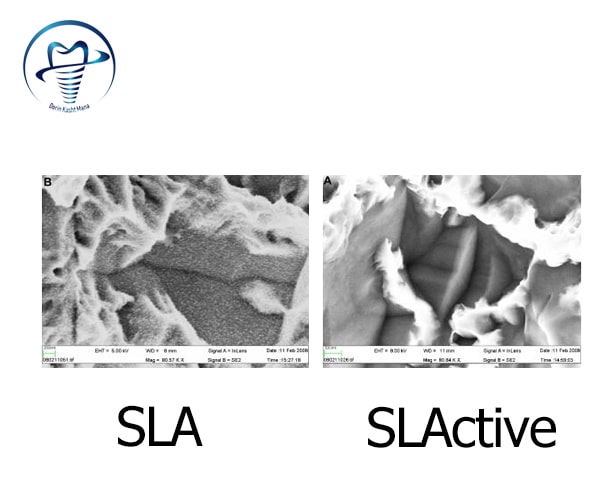Implant Surface Preparation with SLActive
In addition to the SLA method, there is another method called SLActive, which is an abbreviation of Sand blasted Long grit Acid etched Active. In the SLActive surface preparation method, bone formation is accelerated by increasing mineralization and the bone-implant connection is better. Dental implants with SLA and SLActive surface coatings are produced in the same way. Their only difference lies in the last stage of their production process. SLA implants are dried and ready to use after sandblasting and acid washing, or so-called etching. While SLActive implants, after etching, are stored under N2 gas protection and in a 0.9% NaCl (saline solution) solution, which is isotonic (meaning that it neither causes swelling nor shrinkage of cells). The key point in improving dental implants is how blood clots form on the implant. As shown in the figure; Features such as high chemical activity and hydrophilicity of the SLActive surface create a larger surface area for blood protein adsorption and fibrin network formation. This is the most ideal condition for blood clot formation and the initiation of the healing process. This technology reduces the six to eight week healing time in SLA to three to four weeks. Usually, dental implant failure occurs in the early stages of healing, that is, the first two to four weeks after implant placement. The SLActive surface can also accelerate bone healing and bone grafting with the fixture in cases of osteoporosis.
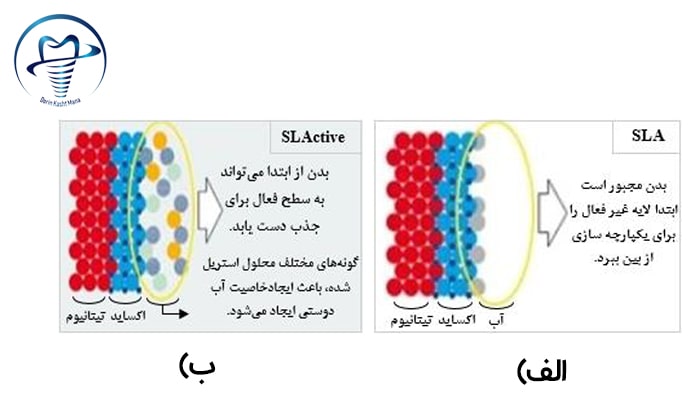
Implant surface preparation by the method: a) SLA and b) SLActive
In fact, the SLActive surface is the same SLA surface that prevents surface titanium oxidation with air, and manufacturers and companies of this method, including the famous Stroman company, claim that this method of treating the surface of the dental implant will provide a faster and better connection quality with the jaw bone. Studies have also shown the high success of this method, and especially in cases where a person has a systemic disease such as diabetes, the implant prosthesis in this method integrates with the surrounding bone and tissue as quickly as possible, and by reducing the bone formation time, the chances of implant operation success have increased. The SLActive method was actually invented by the same Stroman company and is also known as very rapid osseointegration. This method is faster than other methods by activating the implant surface and hydrophilicity, resulting in rapid blood absorption and contact with blood and bone formation. With this method, the adhesion of bacteria to the surfaces is much lower, and as a result, the possibility of infection is reduced. The figure shows the difference between the SLA and SLActive surfaces in blood and protein absorption.
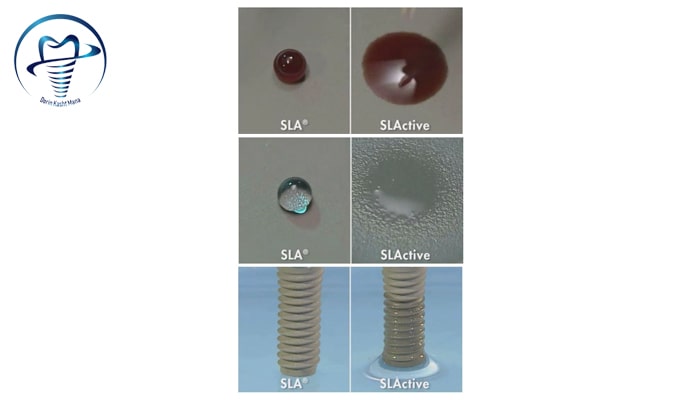
The difference between the SLA and SLActive surfaces in blood and protein absorption
In recent years, many experimental and clinical studies have been conducted on surface preparation using the SLActive method due to the better bone bonding responses in this method compared to the previously mentioned methods. In this regard, Wennerberg et al. conducted a study on the hydrophilic properties of the SLActive method in 2011 and compared this method with the SLA surface preparation method. The results of their work, which were carried out on fifteen test samples of the implant surface, showed that the SLActive method had better hydrophilic properties than the SLA method, so that in the first six to eight weeks after treatment and bone formation, the SLActive method accelerated the bone formation process and worked more effectively. The figure shows the SEM images obtained from their research results. Also, according to their results, in addition to increasing the amount of connection and bone graft strength in the SLActive method, the speed of this connection and integration has also increased compared to the SLA method, at a certain time.
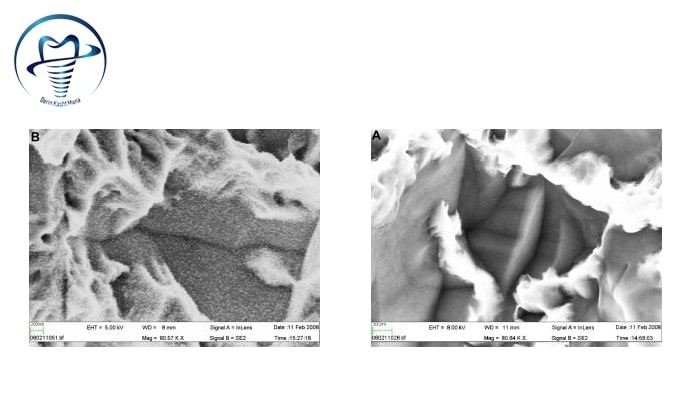
Comparison of the two implant surface preparation methods in Wennerberg’s research work Right image SLActive, left image SLA
In another study, Silva et al. compared the two SLA and SLActive methods in 2020. The results shown in the figure indicated that the SLActive surface preparation method accelerated the bone union between the implant surface and the gingival bone by two to four weeks and formed a better bone union.
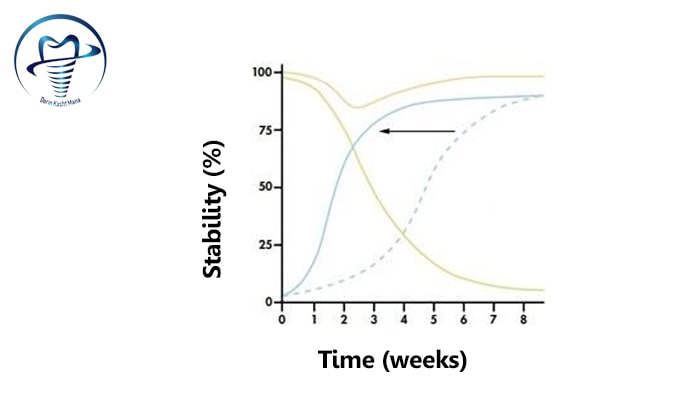
Comparison of the durability of two implant surface preparation methods in Wennerberg’s research work
In a similar vein, in a study conducted in 2002 by Cochran et al., a two-step acid etching technique was performed by immersing titanium implants for several minutes in a mixture of concentrated HCL and H2SO4 heated to a temperature of over 100°C. According to their research results, the two-step acid etching produced microscopic roughness and accelerated the rate of osseointegration with long-term success of more than three years. The hypothesis of these studies was that two-stage acid-etched implants have topographic features that can adhere to the fibrin scaffold and promote osteogenic cell adhesion, thereby accelerating bone deposition. Surface wettability also promotes fibrin adhesion. This fibrin adhesion provides a contact guide for osteoblast migration along the surface. Their research also found that two-stage acid-etched surfaces showed greater bone-to-implant contact and less bone resorption than machined or TPS surfaces.
آماده سازی سطح ایمپلنت به روش SLActive
در کنار روش SLA ، روش دیگری به نام SLActive که مختصر شده ی عبارت Sand blasted Long grit Acid etched Active میباشد، نیز وجود دارد. در روش آماده سازی سطح SLActive ، با افزایش کانی سازی، به تشکیل استخوان سرعت بیشتری بخشیده میشود و اتصال استخوان با ایمپلنت، بهتر انجام میپذیرد. ایمپلنت های دندانی با پوشش های سطحی SLA و SLActive به یک روش تولید میشوند. تنها تفاوت آنها در آخرین مرحله فرایند تولیدشان نهفته است. ایمپلنت های SLA پس از سند بلاست و شست و شوی اسیدی یا اصطلاحاً اچ کردن، خشک شده و آماده استفاده میباشند. در حالی که ایمپلنت های SLActive ، پس از اچ کردن، تحت شرایط محافظت گاز N2 و درمحلول 0.9 درصد از NaCl (محلول نمکی) که ایزوتونیک است (به این معنی که نه باعث تورم سلولها میشود نه سبب چروکیدگی آنها)، ذخیره میشود. نکته اساسی در بهبود ایمپلنت دندان، نحوه شکل گیری لخته خون بر روی ایمپلنت است. همان طور که در شکل، نشان داده شده است؛ ویژگی هایی مانند فعالیت شیمیایی بالا و آبدوستی سطح SLActive ، سطح وسیع تری برای جذب پروتئین خون و ایجاد شبکه فیبرینی ایجاد میکند. این حالت ایده آلترین وضعیت برای تشکیل لخته خون و شروع فرآیند بهبود است. این تکنولوژی زمان شش تا هشت هفته ای بهبود در SLA را به سه تا چهار هفته کاهش میدهد. معمولاً عدم موفقیت در ایمپلنت دندان، در مراحل اولیه بهبود، یعنی دو الی چهار هفته اول پس از کاشت ایمپلنت رخ میدهد. سطح SLActive همچنین میتواند در موارد ابتلا به پوکی استخوان، ترمیم استخوان و پیوند استخوان با فیکسچر را سرعت بخشد.

در واقع، سطح SLActive ، همان سطح SLA است که از اکسیداسیون تیتانیوم سطحی با هوا جلوگیری نموده و سازندگان و کمپانی های این روش از جمله شرکت معروف اشترومن، مدعی هستند که این روش درمانی سطح ایمپلنت دندان، سرعت و کیفیت اتصال بهتری با استخوان فک ایجاد خواهد نمود. همچنین مطالعات نشان از موفقیت بالای این روش داشته و به خصوص در مواردی که فرد دارای بیماری سیستمیک مانند دیابت میباشد، پروتز ایمپلنت در این روش، هر چه سریعتر با استخوان و بافت اطراف خود یکپارچه گردیده و با کاهش زمان استخوان سازی، شانس موفقیت عملیات ایمپلنت را افزایش داده است. روش SLActive در واقع توسط همان شرکت اشترومن ابداع گردیده است و به اسئواینتگریشن بسیار سریع نیز، شناخته میشود. این روش با اکتیو شدن سطح ایمپلنت و هیدروفیلیسیتی و در نتیجه جذب سریع خون و ایجاد تماس با خون و تشکیل استخوان، سریعتر از روش های دیگر میشود. با این روش میزان چسبندگی باکتری ها به سطوح، بسیار کمتر میشود و در نتیجه احتمال عفونت کاهش مییابد. در شکل، تفاوت سطح – SLA و SLActive در جذب خون و پروتئین نشان داده شده است.

در سال های اخیر مطالعات تجربی و بالینی بسیاری در ارتباط با آماده سازی سطح به روش SLActive به دلیل پاسخ های اتصال استخوانی بهتر در این روش، نسبت به روش های قبلی ذکر شده، انجام گرفته است. در همین راستا، ونربرگ و همکاران در سال 2011 به تحقیق بر روی خواص آبدوستی روش SLActive پرداختند و این روش را با روش آماده سازی سطح SLA مقایسه نمودند. نتایج کار آنان که بر روی پانزده نمونه آزمایش از سطح ایمپلنت انجام گرفت، نشان دهنده ی خاصیت آبدوستی بهتر روش SLActive نسبت به روش SLA بود، به طوری که در شش تا هشت هفته ی اولیه ی پس از درمان و استخوان سازی، روش SLActive ، روند استخوان سازی را تسریع نموده و مؤثرتر عمل کرد. شکل، تصاویر SEM حاصل از نتایج تحقیق ایشان را نشان میدهد. همچنین طبق نتایج ایشان، علاوه بر افزایش میزان اتصال و قدرت پیوند استخوانی در روش SLActive ، سرعت این اتصال و یکپارچگی
نیز نسبت به روش SLA ، در یک زمان مشخص، بیشتر شده است.

در تحقیق دیگری، سیلوا و همکاران در سال 2020 به مقایسه دو روش SLA و SLActive پرداختند. نتایج مطابق شکل، حاکی از آن بود که روش آماده سازی سطح SLActive ، پیوند استخوانی بین سطح ایمپلنت و استخوان داخل لثه را دو الی چهار هفته تسریع بخشیده و پیوند استخوانی بهتری را تشکیل میدهد.

در همین راستا در مطالعه ای که در سال 2002 توسط کوچران و همکاران انجام شد، تکنیک اسید اچ دو مرحله ای با غوطه ور نمودن ایمپلنت های تیتانیومی برای چندین دقیقه در مخلوطی از HCL و H2SO4 غلیظ شده که در دمای بالای صد گرم میشود را انجام دادند. طبق نتایج تحقیقات آنها، اسید اچ دو مرحله ای، خشونت در سطح میکروسکوپی را تولید کرده و باعث تسریع در سرعت یکپارچه سازی استخوانی با موفقیت بلند مدتِ، بیش از سه سال خواهد شد . فرضیه ی این مطالعات این بود که ایمپلنت های اسید اچ شده دو مرحله ای، توپوگرافی ویژگیهایی دارند که میتوانند به داربست فیبرینی بچسبند و چسبندگی سلول های استئوژنیک را تسریع کنند و در نتیجه منجر به تسریع رسوب استخوان شوند. قابلیت ترشوندگی سطح، همچنین باعث تسریع چسبندگی فیبرینی نیز میشود. این چسبندگی فیبرین باعث هدایت تماسی برای مهاجرت استئوبلاست ها در طول سطح میشود. همچنین از تحقیقات ایشان در یافته شد که سطوح اسید اچ دو مرحله ای، تماس استخوان به ایمپلنت بیشتر و تحلیل استخوان کمتری را نسبت به سطوح ماشین شده و یا TPS نشان میدهد.
مجموعه درین کاشت مانا به عنوان بزرگترین تولید کننده ایمپلنت های دندانی در ایران، این افتخار را دارد تا با تولید محصولات باکیفیت از مواد اولیه درجه یک و مطابق با استاندارد های روز دنیا، گامی بلند در جهت خودکفایی کشور در زمینه تولید انواع ایمپلنت های دندانی برداشته و محصولات خود را با بهترین قیمت در اختیار دندانپزشکان و مصرف کنندگان قرار می دهد.
جهت کسب اطلاعات بیشتر و ثبت سفارش از طریق این لینک وارد فروشگاه شوید و یا از طریق راه های ارتباطی مجموعه با کارشناسان ما در تماس باشید.
درین کاشت مانا بزرگترین تولید کننده ایمپلنت های دندانی در ایران
جهت خرید ایمپلنت های ایرانی 3A با این شماره تماس بگیرید.
شماره تماس : 02126855680
شماره تماس : 09120383407

